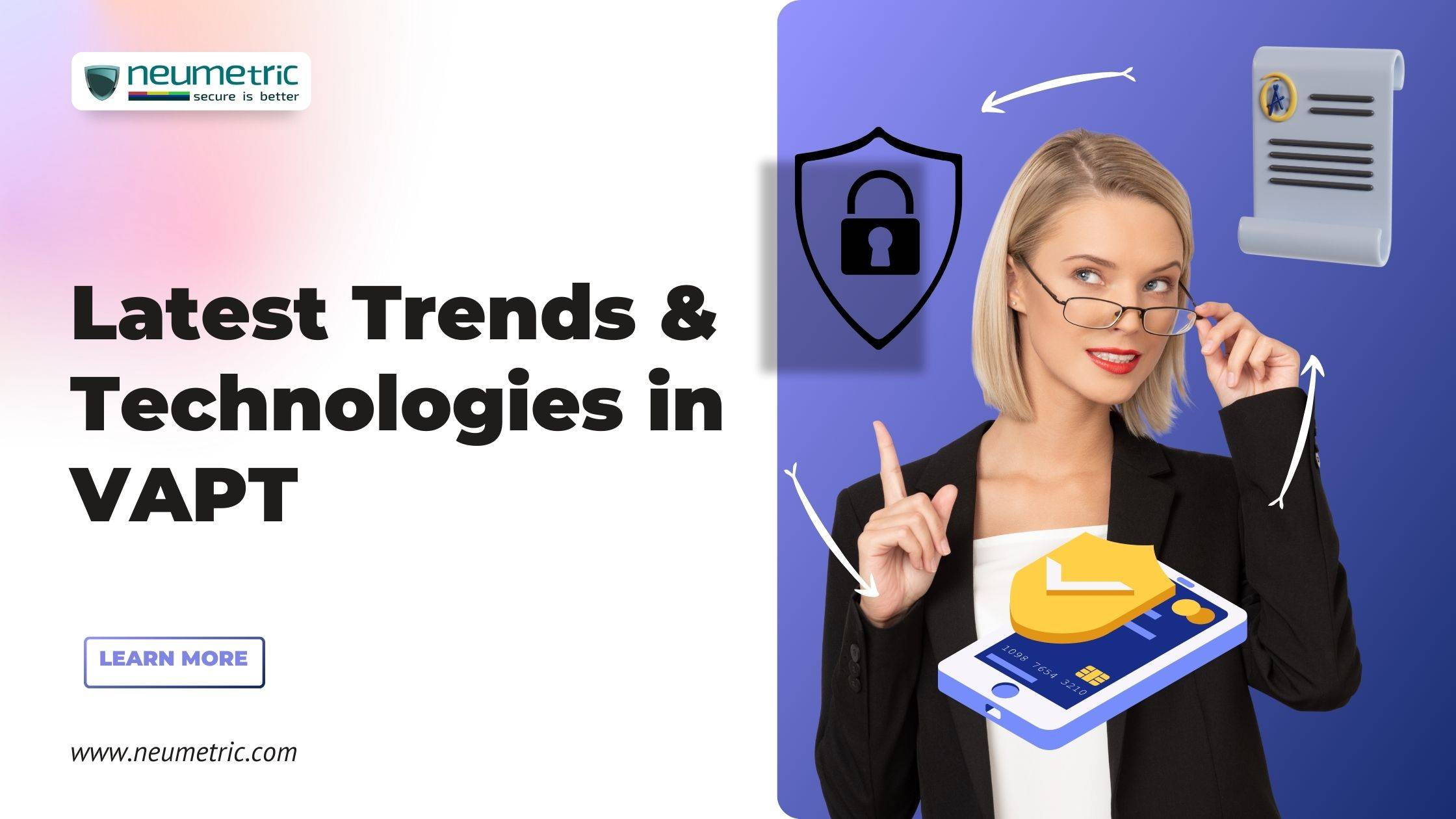Table of Contents
ToggleIntroduction
In the ever-evolving landscape of cybersecurity, Vulnerability Assessment & Penetration Testing [VAPT] stand as crucial pillars of defence against malicious actors. VAPT involves a proactive approach, identifying & addressing vulnerabilities before they can be exploited by cyber threats.
Staying ahead in the world of cybersecurity is not just an option—it’s a necessity. Technologies advance, so do tactics of cybercriminals. Remaining current with the latest trends & technologies ensures that security measures remain robust & adaptive to emerging threats.
This Journal dives into the latest trends & technologies shaping the VAPT landscape. From the integration of Artificial Intelligence [AI] & blockchain security to addressing challenges in the cloud & IoT environments, we explore how VAPT is evolving to safeguard digital assets effectively.
Evolution of VAPT: A historical perspective
The roots of VAPT trace back to the early days of computing when the focus was primarily on building systems rather than securing them. As the internet grew, so did the need for robust security measures, leading to the birth of VAPT. The initial stages involved manual testing, but over time, automation & advanced methodologies became integral.
From the first manual penetration tests to the development of automated tools, VAPT has seen significant milestones. The evolution continues with the integration of Artificial Intelligence [AI], Machine Learning [ML] & a shift toward proactive, continuous testing. These milestones reflect the industry’s commitment to staying ahead of emerging threats.
The threat landscape is in a constant state of flux, with cybercriminals becoming more sophisticated. Adapting VAPT methodologies to these changes is crucial for maintaining a robust defence. The significance lies not only in identifying vulnerabilities but also in understanding & mitigating the constantly evolving tactics employed by malicious actors.
Current cybersecurity landscape
In today’s digital era, cybersecurity challenges have reached unprecedented levels of complexity. From sophisticated phishing attacks to ransomware exploits, the threats organisations face are diverse & continually evolving. Cybercriminals leverage advanced tactics, exploiting vulnerabilities in software, networks & human behaviour. The sheer scale & sophistication of these challenges make it imperative for organisations to reassess & fortify their cybersecurity strategies.
Role of VAPT in mitigating modern threats: Vulnerability Assessment & Penetration Testing [VAPT] emerge as frontline defenders in the battle against modern cyber threats. Unlike traditional security approaches, VAPT takes a proactive stance by identifying & addressing vulnerabilities before they can be exploited. It goes beyond mere detection, actively testing the resilience of systems against real-world attack scenarios. By doing so, VAPT not only helps organisations stay one step ahead but also acts as a strategic shield against potential breaches & unauthorised access.
Need for proactive & dynamic security measures: The reactive approach to cybersecurity is no longer sufficient. The need of the hour is a proactive & dynamic security posture. VAPT embodies this ethos by continually adapting to the evolving threat landscape. Static security measures are akin to standing still in the face of an advancing enemy, whereas VAPT is akin to a vigilant sentry, anticipating & thwarting potential threats before they manifest. In an environment where threats are dynamic & multifaceted, the agility & adaptability of VAPT become indispensable components of a robust cybersecurity strategy.
Artificial Intelligence [AI] & Machine Learning [ML] integration
Artificial Intelligence [AI] & Machine Learning [ML] have revolutionised the field of VAPT, ushering in an era of intelligent & adaptive cybersecurity. The integration of AI & ML brings a cognitive dimension to security practices, enabling systems to learn, evolve & respond autonomously to emerging threats. This transformative synergy marks a paradigm shift from rule-based security models to intelligent, data-driven approaches.
Automated threat detection & response: One of the pivotal roles of AI & ML in VAPT is in automating the detection & response to cyber threats. These technologies excel at analysing vast datasets, identifying patterns & discerning anomalies indicative of potential security breaches. Automated threat detection ensures swift responses to real-time threats, minimising the window of vulnerability & enhancing overall cybersecurity resilience.
Real-time adaptive security measures: The dynamic nature of cyber threats demands real-time adaptability in security measures. AI & ML empower VAPT to continuously learn from new data, adjusting security protocols on the fly. This adaptability is crucial in countering threats that morph & evolve rapidly. The ability to dynamically recalibrate defences based on the latest threat intelligence ensures that organisations maintain a robust security posture in the face of emerging challenges.
Blockchain security & VAPT
Securing blockchain environments poses unique challenges due to their decentralised & transparent nature. The immutability of the ledger doesn’t exempt it from vulnerabilities. Blockchain faces threats such as smart contract exploits, consensus algorithm weaknesses & the potential for 51% attacks. VAPT becomes crucial in identifying & addressing these vulnerabilities to uphold the integrity of the blockchain & prevent unauthorised access or manipulation.
Unique aspects of VAPT for decentralised systems: Decentralisation introduces a paradigm shift in security dynamics. Traditional centralised security models don’t fully apply to blockchain. VAPT for decentralised systems must consider consensus mechanisms, smart contract audits & the intricate web of nodes. Testing the resilience of a decentralised network requires a specialised approach, focusing on ensuring the robustness of each node & the overall network consensus.
Ensuring integrity & confidentiality in distributed ledger technology: Integrity & confidentiality are the pillars of trust in any blockchain. VAPT for distributed ledger technology aims to maintain the integrity of transactions & the confidentiality of sensitive information. This involves scrutinising encryption methods, validating consensus mechanisms & ensuring that the smart contracts executing on the blockchain are secure. VAPT becomes the guardian, preserving the fundamental principles that make blockchain a reliable & secure technology.
Cloud security trends & VAPT best practices
Cloud computing has reshaped the way organisations operate, but it comes with its set of security challenges. From misconfigured cloud settings to data breaches, the cloud landscape is dynamic. Current trends include the rise of multi-cloud environments, increased focus on identity & access management & the need for advanced threat detection. Understanding these trends is essential for implementing effective security measures.
VAPT strategies tailored for cloud environments: Securing the cloud requires a nuanced approach & VAPT strategies need to align with the unique challenges posed by cloud architectures. VAPT for the cloud involves assessing the security of data storage, network configurations & the overall infrastructure. It also includes evaluating the security of APIs, which play a pivotal role in cloud-based applications. Tailoring VAPT strategies to the cloud ensures a comprehensive assessment of the entire digital ecosystem.
Addressing the shared responsibility model in cloud security: Cloud security operates on a shared responsibility model, where both the cloud service provider & the customer have defined responsibilities. VAPT plays a crucial role in ensuring that both parties meet their obligations. For the customer, this involves securing data & applications, while the provider is responsible for the security of the cloud infrastructure. VAPT acts as the bridge, verifying that each entity fulfils its part to maintain a secure cloud environment. This shared responsibility underscores the collaborative effort needed for robust cloud security.
Zero Trust Architecture [ZTA] & VAPT
In the ever-shifting landscape of cybersecurity, the concept of trust has undergone a paradigm shift. Enter Zero Trust Architecture [ZTA], a philosophy that challenges the traditional notion of trusting entities within a network implicitly. In a Zero Trust model, trust is never assumed & every user & device, regardless of their location, is treated as potentially untrusted. This introduction marks a fundamental shift from perimeter-based security to a more dynamic & adaptive approach.
Key principles & concepts: Zero Trust Architecture operates on a set of key principles. These include the idea of verifying the identity of every user & device, implementing least privilege access, continuously monitoring & analysing network activities & assuming that a breach is inevitable. This approach emphasises a proactive stance, assuming that threats can come from both internal & external sources & security measures need to be applied at every level of the network.
Integrating VAPT into a Zero Trust framework: Vulnerability Assessment & Penetration Testing [VAPT] seamlessly integrate into the fabric of Zero Trust. VAPT acts as the investigative arm, constantly probing & assessing the security posture of the network. By identifying vulnerabilities & testing the resilience of the architecture, VAPT aligns with the principles of Zero Trust, ensuring that every potential point of weakness is addressed & access privileges are consistently reevaluated.
Enhancing security in remote & distributed environments: With the rise of remote work & distributed teams, the traditional security perimeter has dissolved. Zero Trust Architecture, combined with VAPT, becomes particularly crucial in such scenarios. VAPT helps in evaluating the security of remote access points, ensuring that devices connecting from various locations adhere to the same stringent security standards. This dynamic approach is vital for maintaining a robust security posture in an era where the concept of the office is no longer confined to a physical space.
IoT security challenges & VAPT solutions
As the Internet of Things [IoT] continues to weave itself into the fabric of our daily lives, the security challenges it presents are growing exponentially. From smart home devices to industrial sensors, each connected endpoint becomes a potential entry point for malicious actors. Concerns include the vulnerability of IoT devices to cyber attacks, the lack of standardised security protocols & the potential for large-scale breaches due to the sheer volume of interconnected devices.
VAPT methodologies for connected devices: Vulnerability Assessment & Penetration Testing [VAPT] step into the breach, providing a tailored approach to address the unique challenges posed by IoT security. VAPT methodologies for connected devices involve assessing the firmware & software vulnerabilities of IoT devices, scrutinising communication protocols & evaluating the overall ecosystem’s susceptibility to various cyber threats. This proactive approach helps organisations identify & rectify potential weaknesses before they can be exploited.
Securing the expanding attack surface in the Internet of Things: The expanding attack surface in the Internet of Things requires a comprehensive strategy. VAPT acts as a frontline defender, not only identifying vulnerabilities in individual devices but also testing the interconnectedness of the entire IoT ecosystem. By securing communication channels, ensuring robust authentication mechanisms & validating data integrity, VAPT mitigates the risks associated with the expanding attack surface in the IoT landscape. This is vital for ensuring that the benefits of IoT innovation can be harnessed without compromising security.
Compliance & VAPT alignment
In the ever-evolving landscape of cybersecurity, regulatory frameworks serve as the guiding light, setting the standards for securing sensitive data. These frameworks, such as GDPR, HIPAA & others, outline the legal obligations & responsibilities that organisations must uphold to safeguard information. Non-compliance not only invites hefty fines but also tarnishes the reputation of businesses. As the regulatory landscape tightens, the need for a robust Vulnerability Assessment & Penetration Testing [VAPT] strategy becomes non-negotiable.
Importance of compliance in VAPT: Compliance & VAPT are inseparable companions on the journey to a secure digital environment. VAPT not only aligns with regulatory requirements but goes beyond, providing a proactive defence against potential threats. Compliance sets the baseline & VAPT ensures that the security measures are not just meeting the bare minimum but are resilient enough to withstand the ever-changing threat landscape. The marriage of compliance & VAPT is the key to building trust with customers, partners & regulatory bodies.
Conclusion
The world of cybersecurity is akin to a chessboard where the adversary is constantly changing the rules. In such a dynamic environment, the importance of continuous learning & adaptation cannot be overstated. Vulnerability Assessment & Penetration Testing [VAPT] are not one-time exercises; they are ongoing processes that demand vigilance & a commitment to staying ahead of the curve. Organisations must view VAPT as a journey, not a destination, ensuring that their security measures evolve alongside the ever-shifting threat landscape.
Organisations must heed the lessons of the trends & technologies discussed & weave them into the fabric of their cybersecurity strategies. From the principles of Zero Trust Architecture to the intricacies of securing the Internet of Things, every advancement is a building block in the fortress of digital defence. It’s time for organisations to not only embrace change but to lead it, ensuring that their cybersecurity strategies are not just effective today but resilient for the challenges that tomorrow will undoubtedly bring. The journey continues & the path forward is one of perpetual learning, adaptation & a commitment to securing the digital frontier.
FAQ
How does Vulnerability Assessment & Penetration Testing [VAPT] adapt to the unique challenges of blockchain security?
Blockchain is often hailed for its security, but it’s not immune to vulnerabilities. VAPT plays a crucial role in securing blockchain environments by addressing challenges such as smart contract exploits & potential 51% attacks. It dives deep into the decentralised nature of blockchain, ensuring the integrity & confidentiality of distributed ledger technology. Want to know more about how VAPT safeguards the blockchain? Dive into the details.
How does integrating Artificial Intelligence [AI] & Machine Learning [ML] into VAPT enhance real-time adaptive security measures?
The integration of AI & ML transforms VAPT into a dynamic & intelligent cybersecurity ally. But how does it work? These technologies automate threat detection & response, identifying patterns & anomalies that might escape traditional security measures. In real-time, AI & ML adapt security protocols based on the latest threat intelligence. Curious about real-world examples? Check out case studies that demonstrate the effectiveness of AI & ML in fortifying VAPT strategies.
Why is the marriage of Compliance & VAPT crucial in the cybersecurity landscape?
Regulatory frameworks set the rules, but how does VAPT complement & go beyond compliance? VAPT not only ensures adherence to regulations but elevates cybersecurity by proactively identifying vulnerabilities. Compliance is the baseline & VAPT ensures that security measures not only meet but exceed the requirements. Intrigued by success stories? Explore case studies illustrating how organisations have successfully aligned compliance & VAPT, creating a robust defence against cyber threats.





